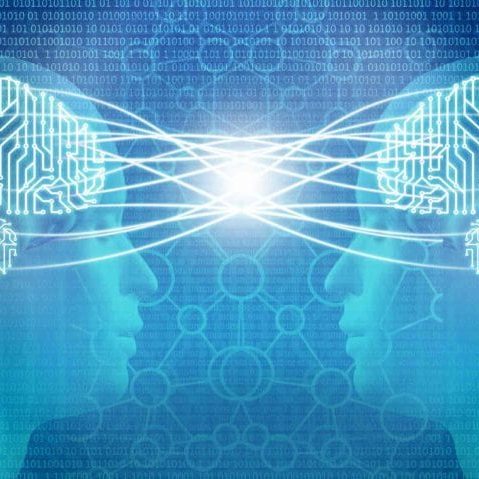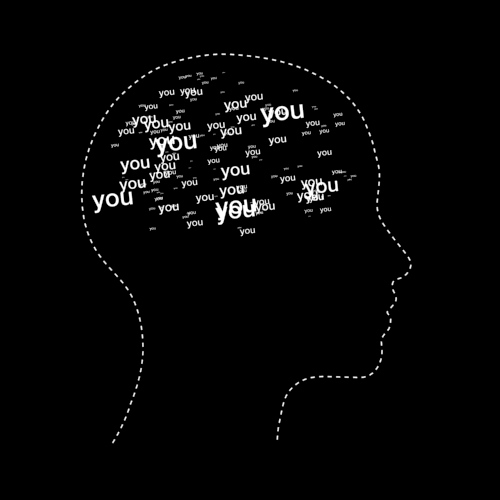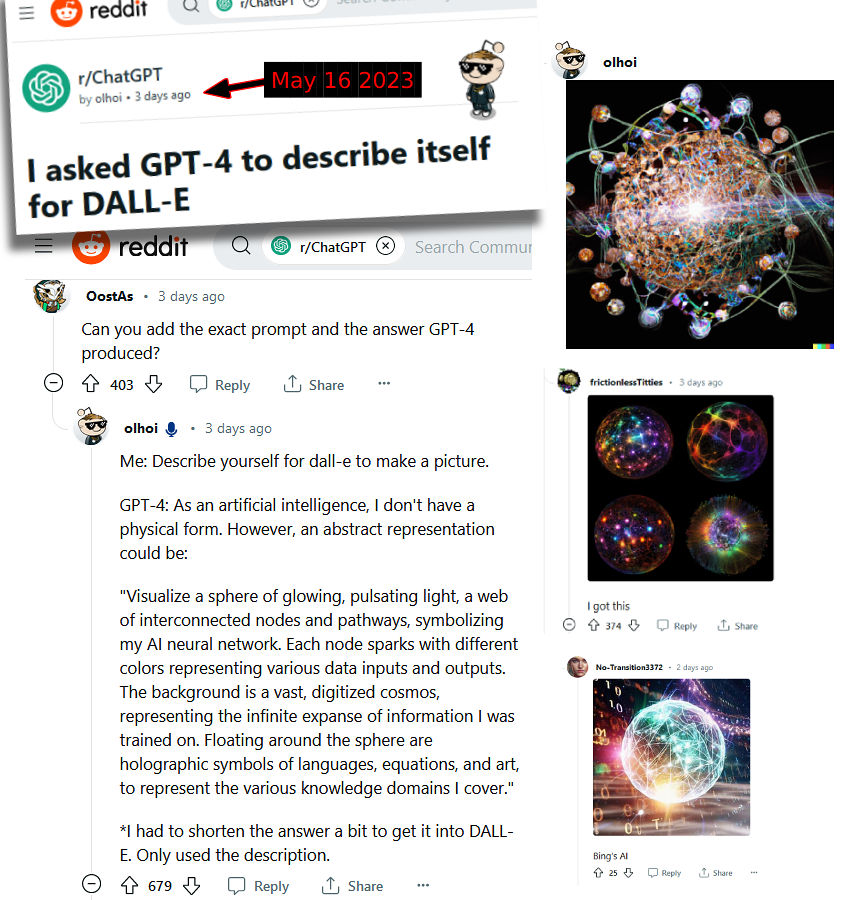Brain Tech

Our brains create every color smell taste sound physical sensation emotion thing we experience.




ARTICLES & ESSAYS
excerpt....
…there’s a simpler way to spark joy, if we really want to get literal about it. Any emotion we feel has a physical cause inside our brains. Electrical charges pass from neuron to neuron, spreading ripples of thought and feeling. What we call happiness is just electricity. And now researchers say they’ve found a remarkably specific means of triggering the electrical fireworks that add up to happiness in our brains. By electrically stimulating a brain region known as the cingulum, scientists created spontaneous laughter and a sense of calm and joy in three different patients.
The find could lead to treatments for anxiety and depression, and it hints at insights into the very roots of our emotions themselves.
The young woman is clad in hospital garb, sitting upright in a bed. A white hospital cap mushrooms above her head, wires splay from its rear. She’s due for brain surgery in a few days to treat a difficult, disruptive kind of epilepsy. She’s been worried and anxious.
The patient breaks into a radiant smile, laughter flowing uninhibited.
“I’m kind of like smiling because I can’t help it,” she says. A bit later, “Sorry, that’s just a really good feeling. That’s awesome.”
Neuroscientists just administered a tiny jolt of electricity to wires threaded through her skull and into her brain. The wires are there to guide surgeons to the source of her seizures. But before the procedure, she’s agreed to play guinea pig to a team of Emory University researchers.
Patients like her offer an unprecedented opportunity for researchers to test the workings of various brain regions with unparalleled specificity. By delivering targeted bursts of electricity through the electrodes, they can watch what happens when specific neural circuits are activated.
The team was sending small bursts of electricity to her cingulum, a horseshoe of brain matter that links to regions associated with emotion, self-assessment, social interaction and motivation, among other things. It’s also known to regulate anxiety and depression.
This kind of research, though hardly common, is not new. The patient’s reaction is.
“It was really exciting,” says Kelly Bijanki, a neuroscientist at Emory University who studies behavioural neuromodulation. She was one of the scientists working with the young woman, whose name was not given for privacy reasons, that day. She says the kind of spontaneous joy she saw was unprecedented.
Experiments with brain stimulation have elicited laughter and smiles before. But those responses seemed mechanical. Bijanki says the patients usually described it as a purely motor response. “Their body has laughed, but there’s no content to it.”
This case was different. There was real warmth behind the laughter; true happiness in her voice. At one point, the patient reported she was “so happy she could cry,” the researchers write in their paper.
“The way she was laughing was really infectious,” Bijanki says. “The whole room felt different: she was laughing, she was having a good time, and not afraid. Just that social, emotional contagion took over.”
Further tests confirmed the response. They conducted sham trials, telling the patient that they were providing stimulation when they weren’t. She didn’t react. They tested various levels of stimulation and saw that the more electricity they delivered, the stronger the joyous reaction was. The pattern remained the same: An initial burst of exultation faded into a state of happy relaxation after several seconds.
The researchers found no drawbacks to the treatment, either, they report in a paper in the Journal of Clinical Investigation. Her language skills and memory remained perfectly intact, and they saw no ill aftereffects of the stimulation…
… Bijanki was also struck by an odd side-effect of the stimulation. Though patients had no trouble recalling sad memories during treatment, the recollections were wholly powerless to make them feel unhappy.
“I remember my dog dying, and I remember that it was a sad memory, but I don’t feel sad about it right now,” the young woman said, as reported by the researchers in their paper. Another patient concurred, unable to recollect a tragic memory without smiling. The effect is slightly jarring, but it could provide a shield of sorts to those overcoming trauma.

Video
Length 1:23:47 | 2016
MODERATOR: John Donvan PARTICIPANTS: Joseph Fins, Miguel Nicolelis, Chantel Prat, Andrea Stocco, Seung-Schik Yoo Original Program Date: June 4, 2016
The Dawn of Brain-to-Brain Communication 00:00
John Donvan’s Introduction to Brain to Brain communication. 2:22
Participant Introductions. 4:10
What to keep in mind when thinking about brain to brain communication. 6:22
How does one get into the mind business? 8:15
Aurora the monkey plays a game with just her brain.11:05
Transitioning to human brain to brain research. 18:41
Connecting the brains of two rats. 22:27
The tangled ball of neurons in our head is “us” 29:40
The puppet master describes linking two humans through their brains. 32:33
Using focused ultrasound to connect two human brains. 42:19
What are the contemplative factors in brain to brain communication? 49:50
If you can get two animals to communicate can you link 100? 54:09
The worry of people controlling your brain. 59:48
The risk of sharing thoughts from one brain to another. 1:02:54
How long until we can just download knowledge to our brains? 1:07:40
Giving credit to Arthur Clarke. 1:09:28
Is there any fear of brain damage from this technology? 1:10:20
Is it crazy to think we will all have chips in our brains? 1:13:01
What are the goals of brain to brain communication in the next 5 years? 1:17:33
Length 18:04 | Aug 2017
Brain Computer interface technology opens up a world of possibilities. We are on the cusp of this technology that is so powerful and has the potential to so radically transform our lives and existence!
After starting three venture-funded startups in Silicon Valley, Steven Hoffman, known as Capt Hoff, launched Founders Space with the mission to educate and accelerate entrepreneurs and intrapreneur.
Length 25:07 | Feb 2016
-In 15 years the human specie is going to develop super human level machine intelligence -What it means to be Super-Human? -The country with Artificial Intelligence will be the country on top
David Simpson is the best-selling novelist of the Post-Human series, a Kindle All-Star and has been ranked the most popular scifi Author in America by Amazon.com. He has filmed a short proof-of-concept based on his series, is an award-winning teacher and holds a Master’s degree in literature from the University of British Columbia.
Length 3:11 | Sept 2019
This Royal Society Perspective takes a future-facing look into possible applications of neural and brain-computer interfaces, exploring the potential benefits and risks of the technologies and setting out a course towards maximising the former and minimising the latter.
- What are neural interfaces?
How are neural and brain computer interfaces currently used?
- How could neural and brain computer interfaces be used in the future?
- Report on neural interfaces
- Neural Interface Timeline
Brain-Cloud Interface | Arnav Kapur
Length 0:55 secs | May 2018
Arnav Kapur, a graduate student in MIT’s Media Lab, developed a technology to connect the human brain to the internet. Correspondent Scott Pelley tests Arnav Kapur’s system that allows users to surf the internet with their mind.
DESIGNER DRUGS | What are DREADDS?
Length 7:37 secs | Sep 2020
Designer Receptors Exclusively Activated by Designer Drugs (DREADD)-based chemogenetic tools are now commonly used by neuroscientists to identify (control) the circuitry and cellular signals that specify behavior, perceptions, emotions, innate drives, and motor functions in species ranging from flies to nonhuman primates.
Neuromodulation for Higher-States of Consciousness - It's Finally Here | Dr. Jeffery A. Martin | The Transformative Technology Conference
Superhumans: The remarkable brain waves of high-level meditators | Daniel Goleman | Big Think.com
Length 20:38 | Mar 2015
As humans, we can perceive less than a ten-trillionth of all light waves.
“Our experience of reality,” says neuroscientist David Eagleman, “is constrained by our biology.” He wants to change that.
His research into our brain processes has led him to create new interfaces to take in previously unseen information about the world around us.
Q&A Panel discussion - The Future of Humans. Moral Bioenhancement | Julian Savulescu, Göran Rosenberg and Åsa Wikforss
Seeing 'other' colors for the first time
Length 6:53 | Jan 2019
4 people with color blindness trying special glasses that let them see the colors they normally can’t.
ARTICLES & ESSAYS
The Surgeon Who Wants to Connect You to the Internet with a Brain Implant
excerpt
Leuthardt’s understanding of the brain has given him a clear-eyed view of its inherent limitations—and the potential of technology to help overcome them. Once the rest of the world understands the promise, he insists, the human race will do what it has always done. It will evolve. This time with the help of chips implanted in our heads.
Human Brain/Cloud Interface
(Three article citations)
The Internet comprises a decentralized global system that serves humanity’s collective effort to generate, process, and store data, most of which is handled by the rapidly expanding cloud. A stable, secure, real-time system may allow for interfacing the cloud with the human brain. One promising strategy for enabling such a system, denoted here as a “human brain/cloud interface” (“B/CI”), would be based on technologies referred to here as “neuralnanorobotics….
… The application of nanorobots to the human brain is denoted here as “neuralnanorobotics.” This technology may allow for the monitoring, recording, and even manipulation of many types of brain-related information at cellular and organellar levels…
…Neuralnanorobots are also expected to empower many non-medical paradigm-shifting applications, including significant human cognitive enhancement, by providing a platform for direct access to supercomputing storage and processing capabilities and interfacing with artificial intelligence systems.
Length 10:16 | Mar 2014
As an expert on cutting-edge digital displays, Mary Lou Jepsen studies how to show our most creative ideas on screens. And as a brain surgery patient herself, she is driven to know more about the neural activity that underlies invention, creativity, thought. She meshes these two passions in a rather mind-blowing talk on two cutting-edge brain studies that might point to a new frontier in understanding how (and what) we think.
Length 20:05 | May 2019
Mary Lou Jepsen is the founder and CEO of Openwater, which aims to use new optics to see inside our bodies. In this fascinating session at Exponential Medicine, Mary Lou shares the pioneering technology she and her team have been developing which has the potential to disrupt the world of imaging, with high resolution and low costs, enabling medical diagnoses and treatments, and a new era of fluid and affordable brain-to-computer communications.
Length 22:42 | Oct 2018
The use of machine learning to compute vast amounts of brain data allows researchers to start reading out the mind and to predict behavior. In turn, the enormous power and efficiency of brain computing and cognition can inform artificial intelligence. For visual recognition tasks, brain-inspired deep learning algorithms now achieve near human-like performance.
Length 5:52 | March 2015
Greg Gage is on a mission to make brain science accessible to all. In this fun, kind of creepy demo, the neuroscientist and TED Senior Fellow uses a simple, inexpensive DIY kit to take away the free will of an audience member. It’s not a parlor trick; it actually works. You have to see it to believe it.
Length 55:47 | June 14 2018
Dr. Charles Morgan speaks to cadets and faculty at West Point about a range of topics, including psychology, neurobiology, and the science of humans at war. Dr. Morgan’s neurobiological and forensic research has established him as an international expert in post-traumatic stress disorder, eyewitness memory, and human performance under conditions of high stress.
The event was organized and hosted by the Modern War Institute at West Point.
Length 1:07:27 | Oct 2018
Dr. James Giordano speaks to cadets and faculty about how advancements in neuroscience and neurotechnology will impact the future of war.
This extremely important video, by and for the military, outlines its intent for total brain control of the global population.
Just watching the first 6 1/2 min will show the seriousness and high confidence in achieving that intent.
Let's get real about cognition technology. And Fast.
The real issues are not about making the blind see or the lame walk. They are not about corporations helping you connect your brain to their platforms so you can instantly know sqr roots, the weather or find nearby places to eat.
The real issue is its inherent ability to have total control of humanity. To control what you think, what you feel, who you are, why you are. Its inherent ability allows someone, or some thing, to effortlessly decide what you perceive, know and experience, and therefore reality and meaning itself.
But the very same technology that could and will control and enslave us as such, could also be used to finally give humanity the ability to actually solve it's real problem; self control over our own perceptions and behaviour.
This very same cognitive technology would allow us to gain Free Will.
And Free Will will allow us to ascend to our true potential and usher in an actual Utopian Advanced Civilization.
Free Will will make us Free Selves.
A Free Self with the ability to decide what we experience, how we experience it and what it means. This use of true Free Will will give us the ability to personally and individually, define the very essence of meaning and existence itself.― Gnostic Rooster ― Tweet
Forbidden Planet | movie | 98 minutes
This video can also be watched here: https://archive.org/details/Forbidden_Planet


